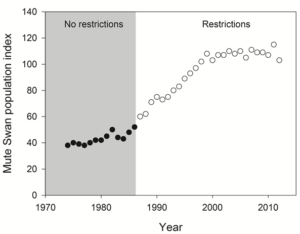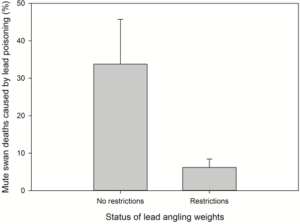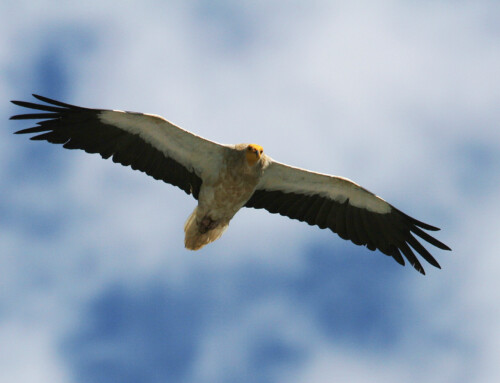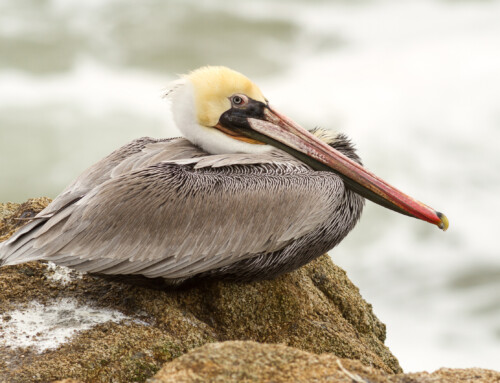LINKED PAPER
Regulation of lead fishing weights results in mute swan population recovery. Wood, K.A., Brown, M.J., Cromie, R.L., Hilton, G.M., Mackenzie, C., Newth, J.L., Pain, D.J., Perrins, C.M. & Rees, E.C. 2019. Biological Conservation. DOI: 10.1016/j.biocon.2018.12.010. VIEW
Humans are having widespread and damaging impacts on the Earth’s biodiversity, due to interlinked factors including climate change, rising and unsustainable use of resources, land‐use changes and intensification, habitat loss and fragmentation, pollution, and invasive species (Hoffman et al. 2010, Butchart et al. 2015). There is more information available than ever before on human impacts on biodiversity, but the solutions to these problems are often not straightforward. Conservationists often call on lawmakers to regulate harmful human activities to alleviate impacts on biodiversity (Hoffman et al. 2010). However, the effectiveness of these regulations may be limited by lack of enforcement or compliance, and by conflicts between the different groups involved (Redpath et al. 2015). Without assessments of the effectiveness of such regulations, there is a greater risk that they could be undermined or revoked, and opportunities to refine or improve the legislation might be missed.
One area where conservationists have been most vocal is in calling for greater regulations on the use of toxic pollutants, such as lead. Lead is harmful to animals even at low levels of exposure (Haig et al. 2014, Delahay & Spray 2015). Over time most industrial uses of lead have been strictly regulated because of concerns regarding its impact on human health. Despite this, lead is still used widely across many countries in recreational activities such as angling and shooting, and during these activities it is released irretrievably into the environment (Haig et al. 2014). Previous research found that >15,000 lead weights (approximately 5 kg) could have been deposited per hectare per year in areas where angling occurred (Bell et al. 1985).
Waterbirds such as Mute Swans Cygnus olor (Fig. 1) are at high risk from lead poisoning as they live in habitats where recreational coarse fishing occurs. Swans consume discarded lead weights whilst feeding or whilst ingesting grit, which they do to aid their digestion of vegetation. In response to findings that lead poisoning was responsible for 4,000 Mute Swans per year and a 15% decline in population size between 1956 and 1978 (Ward et al. 2007), the import, sale, and use of lead weights in the sizes most likely to be eaten by swans (0.06 – 28.35 g) were all banned from January 1987 onward across Great Britain. In a recent study, we assessed how effective these regulations had been in halting and reversing the decline in Britain’s Mute Swan population.

Figure 1 Mute Swans may ingest lead angling weights whilst feeding or searching for grit © Kevin Wood
In the first part of our study, we used 39 years of data available from the Wetland Bird Survey (WeBS: Frost et al. 2016) to assess trends in Mute Swan population size in Great Britain between 1974 and 2012. We found that the changes over time was best explained by the regulation of lead fishing weights, with a large and rapid increase following the restrictions on lead (Fig. 2). Lead regulation accounted for 82% of the between-year variation in Mute Swan population size. In stark contrast, other variables such as arable food supplies, river habitat quality, or winter air temperatures, had little effect on swan population size. Co-ordinated censuses carried out across Great Britain showed that the Mute Swan population increased from approximately 17,600 birds in 1978 to 31,700 in 2002 (Ward et al. 2007). Since the early 2000s, the size of the population has remained relatively stable.

Figure 2 The trend in Mute Swan numbers in Great Britain, which rose sharply following the regulation of lead angling weights
In the second part of our study, we used post-mortem data on swans collected from around Britain to assess the changes in the percentages of Mute Swans known to die from lead poisoning in the periods before and after the lead regulations were introduced. We found that prior to the regulations on lead angling weights, lead poisoning was the biggest single source of mortality amongst the swans, accounting for 34% of all individuals that were analysed. However, the percentages of individuals dying of lead poisoning dropped following the introductions of the regulations, from 34% to 6% (Fig. 3). This large reduction confirmed that lower lead-induced mortality was the likely driver of increased population size in the years following the regulations.

Figure 3 Following the regulation of lead fishing weights from January 1987 onward, post-mortem data showed a drop in the percentage of Mute Swans found to have died of lead poisoning
The results of our study showed that legal restrictions on lead angling weights succeeded in alleviating, although not eliminating, the impact of poisoning on Mute Swans. Our data showed that lead poisoning still accounts for 6% of Mute Swan deaths even after the restrictions on lead fishing weights. These cases could be due to the continued use of legal sizes of lead fishing weights that were not covered by the regulations (e.g. weights below 0.06g and above 28.35g), the persistence of lead weights deposited before the regulations came into force, non-compliance by anglers, and lead poisoning caused by lead from other sources such as ammunition used in shooting (Newth et al. 2013).
Putting comprehensive legal restrictions on the use of toxic substances, to prevent their release into the environment, can provide an effective conservation mechanism for reducing negative effects of human activities on wildlife populations. At a time when many policy makers prefer to rely on voluntary actions or market forces to achieve change, our findings highlight that legal regulations on human activities can offer an effective way of alleviating human impacts on wildlife.
Nominate this article for a BOU Science Communication Award.
References
Bell, D.V., Odin, N. & Torres, E. 1985. Accumulation of angling litter at game and coarse fisheries in South Wales, UK. Biological Conservation 34: 369–379. VIEW
Butchart, S.H., Walpole, M., Collen, B., van Strien, A., Scharlemann, J.P.W., Almond, R.E.A., et al. 2010. Global biodiversity: indicators of recent declines. Science 328: 1164–1168. VIEW
Delahay, R.J. & Spray, C.J. (Eds.) 2015. Proceedings of the Oxford Lead Symposium. Lead Ammunition: understanding and minimising the risks to human and environmental health. Oxford, UK: Edward Grey Institute, University of Oxford. 152pp. VIEW
Frost, T.M., Austin, G.E., Calbrade, N.A., Holt, C.A., Mellan, H.J., Hearn, R.D., Stroud, D.A., Wotton, S.R., & Balmer, D.E. 2016. Waterbirds in the UK 2014/15: The Wetland Bird Survey. BTO/RSPB/JNCC: Thetford, UK. VIEW
Haig, S.M., D’Elia, J., Eagles-Smith, C., Fair, J.M., Gervais, J., Herring, G., et al. (2014). The persistent problem of lead poisoning in birds from ammunition and fishing tackle. Condor 116: 408–428. VIEW
Hoffmann, M., Hilton-Taylor, C., Angulo, A., Böhm, M., Brooks, T.M., Butchart, S.H.M., et al. (2010). The impact of conservation on the status of the world’s vertebrates. Science 330: 1503–1509. VIEW
Newth, J.L., Cromie, R.L., Brown, M.J., Delahay, R.J., Meharg, A.A., Deacon, C., et al. (2013). Poisoning from lead gunshot: still a threat to wild waterbirds in Britain. European Journal of Wildlife Research 59: 195–204. VIEW
Redpath, S.M., Gutierrez, R.J., Wood, K.A., Young, J.C. (2015). Conflicts in Conservation: Navigating Towards Solutions. Cambridge, UK: Cambridge University Press. VIEW
Ward, R.M., Cranswick, P.A., Kershaw, M., Austin, G.E., Brown, A.W., Brown, L.M., et al. (2007). Numbers of mute swans Cygnus olor in Great Britain: results of the national census in 2002. Wildfowl 57: 3–20. VIEW
Image credits
Featured image: Mute Swan Cygnus olor © Kevin Wood




